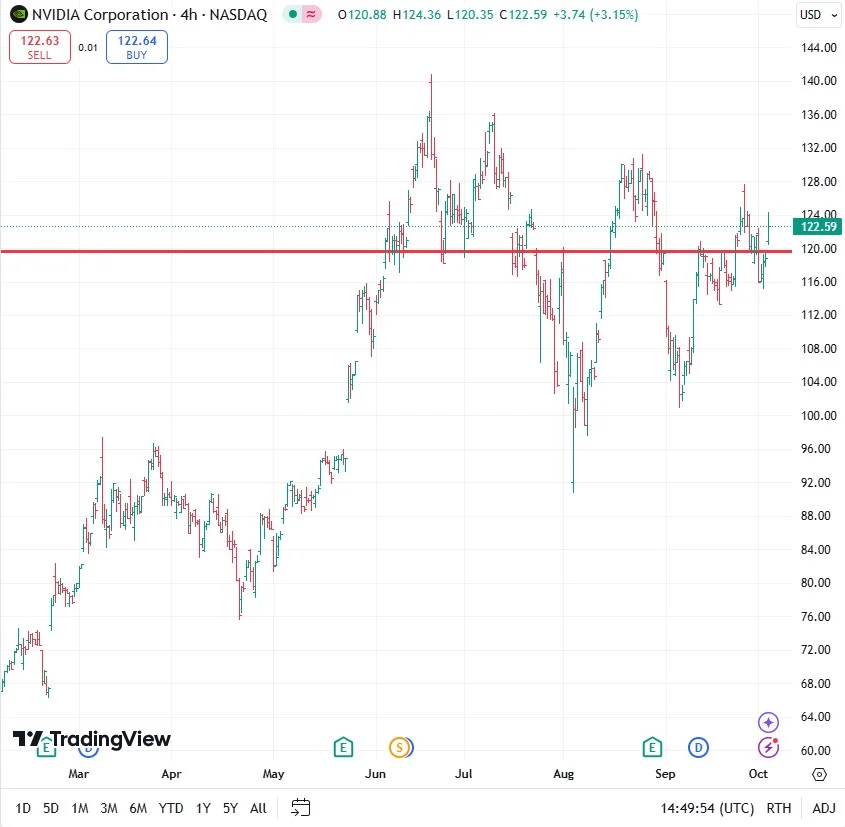- NVIDIA investors are now wondering whether the stock is undergoing a correction or a simple consolidation before a big jump.
- Investors can consider one key metric in the chart to determine NVIDIA stock's next path, and it may not be as good as they think.
- Wall Street and insiders show shifting sentiment for NVIDIA, with the next catalyst being quarterly earnings.
Once the darling of the entire stock market, NVIDIA (NASDAQ:NVDA) is now raising some suspicion as to whether this stock is now in correction territory or whether bulls are only consolidating before coming in with the next wave of aggressive buying. Investors can know this by looking at the chart during the past quarter.
Volume and time are rising trends and strategy factors in the retail investing community. Still, it does work to help figure out where the market thinks a stock could be headed. The way this works is the more time a stock spends in a price range versus another, the more volume and interest there is to keep the stock going in that direction. For NVIDIA, investors might be in a correction trend.
More than this technical gauge, fundamental tailwinds have hit the company recently, making it harder for it to deliver the sort of returns that it once was able to make headlines with. Some in the market already seem to be turning on its head when it comes to NVIDIA stock; all that’s missing now is an analyst sentiment shift, but that’s almost always lagging to the price action.
NVIDIA's Chart Holds the Key: Where the Market Wants to Take It Next
A key level sits right at the middle of the bracket that NVIDIA stock has formed during the past quarter, where most of the volume has taken place. Combining volume and time tells investors this level is the benchmark for measuring sentiment.
That level is $119.75 a share for NVIDIA, and the more time the stock spends above this level, the more bullish the market is on NVIDIA and the higher it wants to take it; the opposite is true when NVIDIA spends more time underneath this level. Over the past quarter, the chart shows more time spent below this level than above, sending a warning.

If the market can keep NVIDIA stock below this $119.75 level for a few more days—or weeks—then investors should really consider selling this stock or at least avoid buying into whatever analyst rating or news headline may come to support it.
Now that the market is entering another earnings season, it could arguably become NVIDIA's most important quarterly report. It could help the market decide which camp it wants to join: whether to keep pushing past above $119.75 or whether the bears will take over and compress NVIDIA below this benchmark level.
Going over recent history, here is what investors can gauge coming from the last earnings report that slowed down NVIDIA stock in the first place.
What Happened in NVIDIA's Last Quarter to Push the Stock Into Its Trading Range?
Like any other commodity business, the semiconductor and chip-making industry goes through what is known as a sales and development cycle, just like a basic materials stock would go through a supply expansion and tightening cycle to withstand swinging commodity prices.
This is the same factor affecting NVIDIA stock today, as the global demand and supply for chips and semiconductors are shifting in favor of supply and out of demand. NVIDIA spent most of the pre-COVID years investing in development and technology advances to bring some of the most sophisticated chips into the market.
However, the years following COVID-19 were nearly all focused on the selling aspect. Now that the selling is done, NVIDIA and other chip makers are starting to pile up inventory, which can impact margins and earnings, not to mention the need to burn through cash as the development cycle gets underway again.
Even the company’s CEO, Jensen Huang, quoted in a recent interview that the market can expect “Lots and lots of supply” regarding NVIDIA’s latest chips. Anyone who understands economics can attest that this statement can mean lower earnings per share (EPS) ahead.
That could be one reason Huang has been selling his own stock over the past year at a clip of over $12 million for each selling block. But he wasn’t alone. Mark A. Stevens, an NVIDIA Director, also sold more than $24 million worth of stock during the month of September.
Smelling blood in the water, the bears started to come in to play the short side of NVIDIA stock, as the company’s short interest has risen by as much as 5.5% in the past month alone, but it’s only a drop in the bucket compared to the $33 billion in total short interest, which had been on the rise over the past quarter.
Willing to stand out from the pack, analysts at DA Davidson decided to place a $90 price target on NVIDIA stock, calling for as much as a 27.3% downside from where the stock trades today. This adds to the bearish evidence supporting the way markets have kept NVIDIA below that key $119.75 benchmark level.
